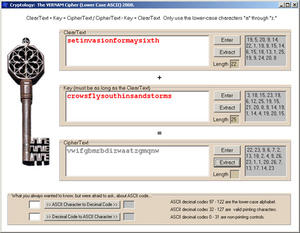EncryptionWWII-like message encryption now available for e-mail security
A Singapore-based company offers an e-mail encryption system based on the Verman cipher, or one-time pad, which was invented in 1917 and used by spies in the Second World War; the Vernam cipher is unbreakable because it produces completely random cipher-text that secures data so that even the most powerful super computers can not break the encryption when it is used properly

Graphic showing principle of the Vernam cypher // Source: duke.edu
Singapore-based Rune Information Security Corporation Pte. Ltd. is showing its Deadbolt encryption solution, which is designed to make data theft through e-mail and messaging intercept a thing of the past for both Macintosh and Windows users.
Rune says it has designed Deadbolt implementing both standards-based OpenPGP and optional, one-time pad for e-mail, messaging, and data. The “pad” alludes to the unbreakable and random Vernam cipher or one-time pad invented in 1917. The Vernam cipher is unbreakable because it produces completely random cipher-text that secures data so that even the most powerful super computers can not break the encryption when it is used properly. During the Second World War, spies used a paper pad that had the randomly generated text to encode and decode their messages. The only way to break the code and read the message was actually to be in possession of the pad. The company says that with Deadbolt, this form of data security guarantees that the recipient of the e-mail who has the pad/key is the only one who can unlock and read the e-mail and attachments.
The company notes that e-mail is especially vulnerable because it is the communications choice for business and individuals, and therefore targeted by governments, corporations, and private investigators. With the release of many commercial off-the-shelf intercept tools, eavesdropping that was once only available to attackers with significant means, like governments, is now within the reach of anyone with a bit of tech savvy and will.
“Deadbolt is designed to easily protect information against all who want to steal or watch your data,” says Lance Gaines, president-CTO of Rune Information Security Corporation. “We can’t stop them from getting access to your system but we do stop them from being able to read sensitive data and information at rest or in motion. If running in the Vernam or one-time pad configuration Deadbolt removes information from the continual ‘crypto arms race’ of ever increasing key lengths; whatever you secure today will be just as secure 1000 years from now.”
The company says that when in Vernam configuration, the Vernam cipher technology platform guarantees that as data traverses from the computer through the World Wide Web, through various servers, phone companies, cable and satellite systems, no governments or hackers can intercept and decipher private messages.
“Rune created a data security product that is uniquely easy to use, and when used correctly, with the appropriate policies, unbreakable,” Gaines continues. “Numerous articles, like ‘The Surveillance Catalog’ appearing in publications like the Wall Street Journal highlight that intercept and hacking tools are now easily and readily available to the masses. Further, daily articles like the ‘Long-Term Nortel Breach’ highlights that a data centric approach needs to be taken to information security. Whether you’re an enterprise executive, a banker trying to maintain financial security, a high-net-worth individual, working with sensitive corporate or personal data, Deadbolt will make sure your secrets stay secret. Deadbolt in Vernam configuration is not crypto for the masses, instead it is crypto for those that need to protect sensitive information and secrets.”
